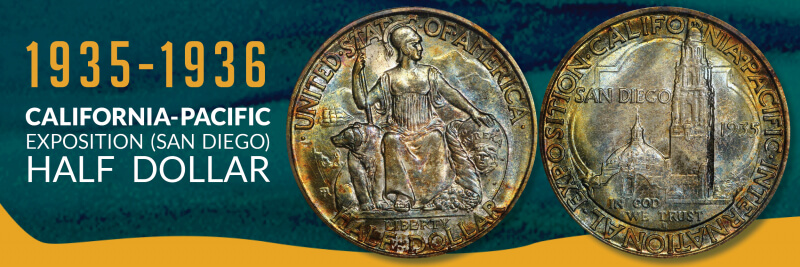
1935-1936 California-Pacific Exposition (San Diego) Half Dollar
Click the images above for enhanced view.
Purpose:
To commemorate the California-Pacific International Exposition held in San Diego and help offset the cost of the fair.
Maximum Number Authorized: 250,000 pieces in 1935. 180,000 pieces in 1936.
Sale Price: $1.00 for the 1935 coin. $1.50 for the 1936 coin.
Designs:
Obverse – Robert Aitken
The California State Seal with a seated Minerva, goddess of wisdom and commerce, facing left. Minerva wears a helmet and holds a staff with her right hand. Her left hand grips a shield that bears the head of Medusa. Above Medusa’s head is the state motto of California, “EUREKA.” Between Minerva and the shield is a cornucopia. A grizzly bear sits at Minerva’s right. Behind them is a gold miner and sailing ship with the outline of the Sierra Madre mountains serving as a background. The designer’s initials are found in the lower left field.
Online Resource: https://mythopedia.com/roman-mythology/gods/minerva/
Reverse – Robert Aitken
Two buildings are featured, both originally constructed for the Panama-California Exposition of 1915 – 1917. The California Tower is in the right field and the Chapel of St. Francis is located to the left. The words “SAN DIEGO” rests above the chapel The inscription “CALIFORNIA PACIFIC INTERNATIONAL EXPOSITION” surrounds the design.
Online Resource: https://www.museumofman.org/california-building/
Popularity:
250,000 coins were minted for sale in 1935. Of those, approximately 70,000 were sold or held back. 180,000 of the 1935 coins were returned to the Mint in exchange for 180,000 half dollars dated 1936. Only 30,000 1936 coins sold, leaving 150,000 to be returned to the Mint. In total, 100,000 San Diego commemoratives were sold and 330,000 were returned and melted.
California Pacific International Exposition Online Resource: https://americasbesthistory.com/wfsandiego1935.html
Trivia:
-
Only a little more than 1 in 5 San Diego commemorative half dollars were sold.
-
In mythology, Medusa had the power to turn an onlooker into stone.
-
The two buildings on the reverse of the coin were a part of the California Pacific International Exposition but they were built for the Panama-California Exposition of 1915.
-
Not all of the exhibits at the Exposition were scientifically based. Examples of unusual exhibits include the Zoro Garden Nudist Colony and the Lost Continent of Mu.
For more information:
Encyclopedia of the Commemorative Coins of the United States by Anthony J. Swiatek
KWS Publishers (2012)
Commemorative Coins of the United States Identification and Price Guide by Anthony J. Swiatek
Amos Press Publishers (2001)
Empress San Francisco: The Pacific Rim, the Great West, and California at the Panama-Pacific International Exposition by Abigail M. Markwyn
University of Nebraska Press Publishers (2014)
References:
Encyclopedia of the Commemorative Coins of the United States by Anthony J. Swiatek
KWS Publishers (2012)
The Encyclopedia of United States Silver & Gold Commemorative Coins 1892 to 1954 by Anthony Swiatek and Walter Breen
Arco Publishing, Inc. (1981)

